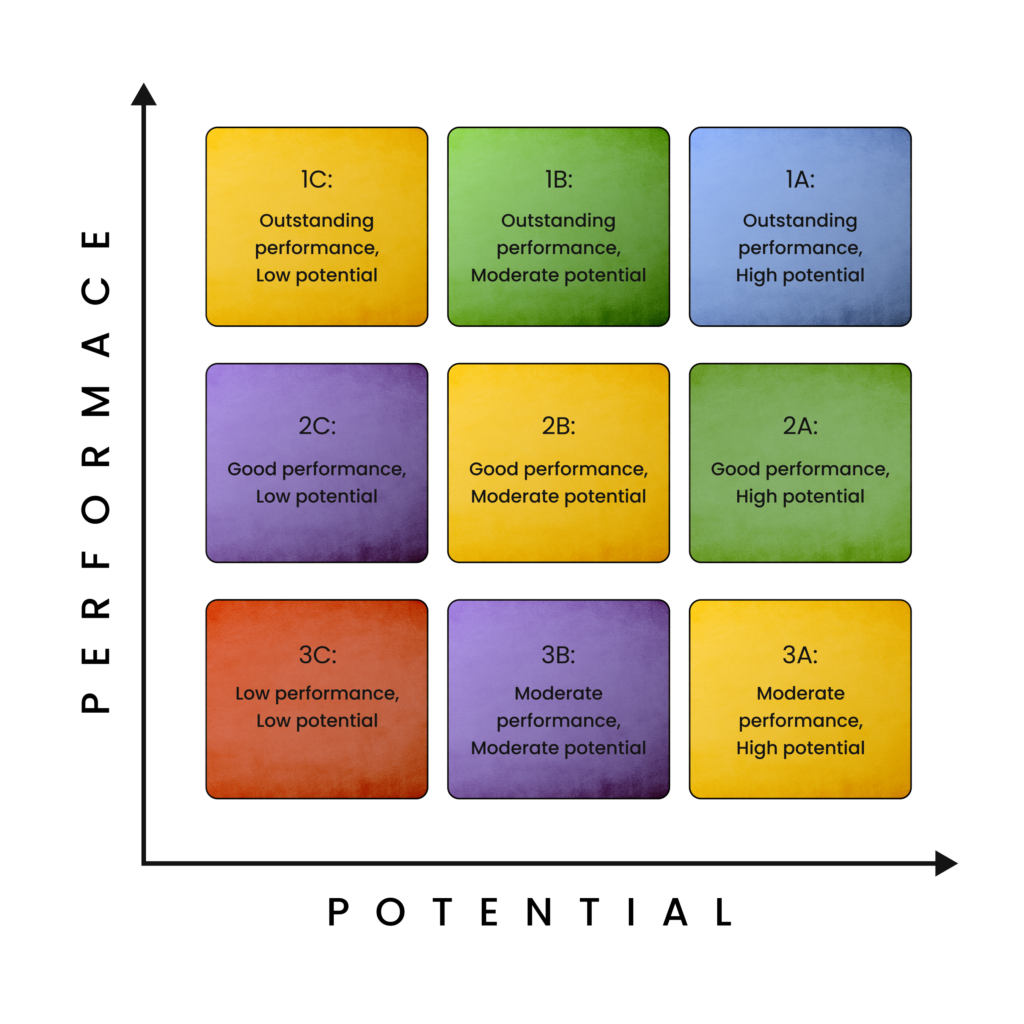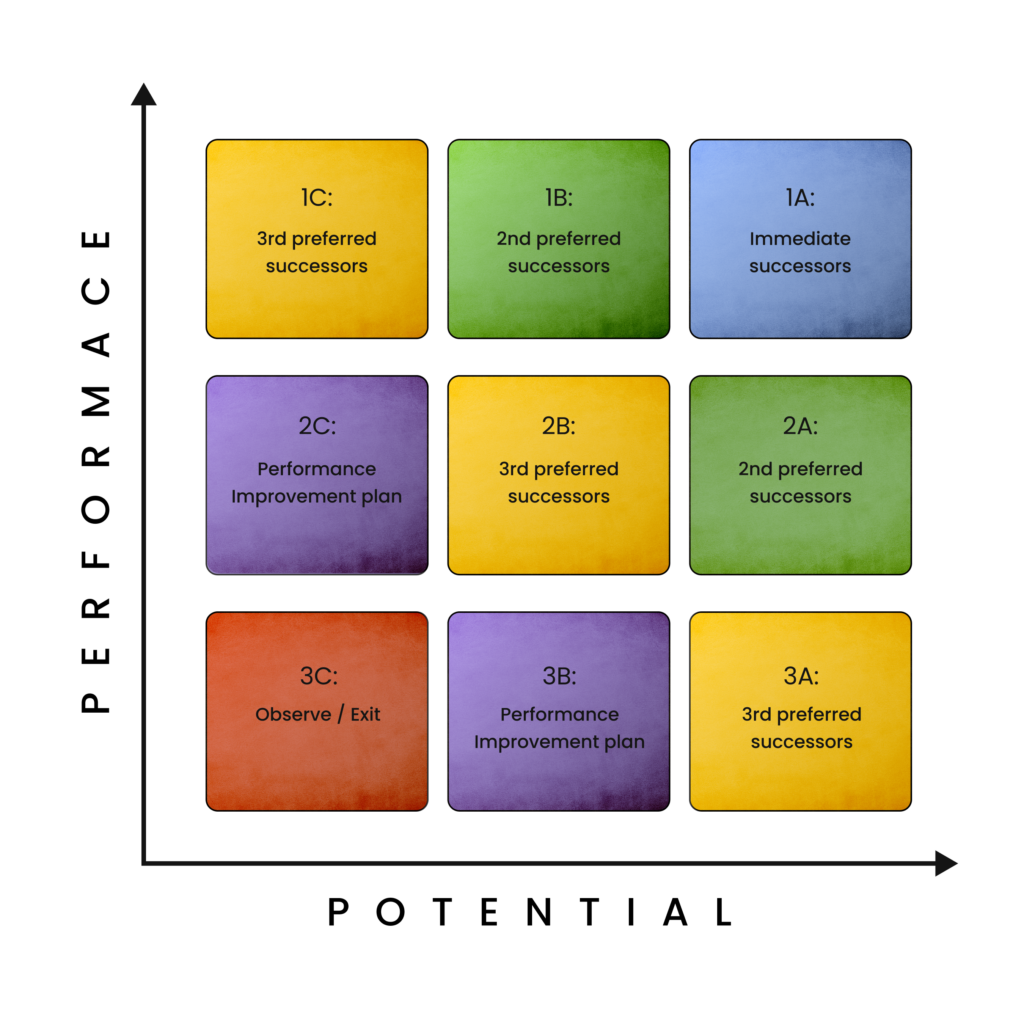Ever wondered if there is a tool to design and implement a fair and effective performance appraisal system that provides timely and constructive feedback, recognizes achievements, and addresses performance gaps? Imagine the 9 box grid as a compass guiding an organization through the intricate landscape of its human capital. It’s more than just a matrix; it’s a window into the stories, aspirations, and journeys of each employee.
9 Box Grid: Framework and Components

The 9 Box Grid employs two axes for evaluation. The x-axis assesses an employee’s past performance, categorizing them as low, moderate, or high based on performance reviews. This could involve levels such as not meeting, meeting, or exceeding job expectations, or using terms like low performing, moderate performing, and outstanding performance.
The y-axis gauges future potential, placing employees into low, moderate, or high categories based on their potential contributions to the company or team. The specific names of these categories may vary between companies, but the fundamental idea remains consistent.
Steps to Use a 9 Box Grid Efficiently
Let’s understand how to use the 9 Box Grid within 3 steps with an example!
Step 1: Prepare a Grid
Mark indicators on the X-axis and Y-axis respectively performance and potential. The indicators can be categorized as Not Meeting, Meeting, or Exceeding job expectations for marking performance and Low, Moderate, or High for potential.
Step 2: Extract Data
Your performance management system will help in extracting data in this step, it is advised that the rating scale for performance and competency should be identical, i.e., if a 5-point scale rating scale is used for measuring performance then the scale for measuring competency should also be a 5-point scale. Competency refers to a set of skills, knowledge, abilities, behaviors, and experiences that enable a person to perform effectively in a specific job or role which aids in determining the potential of the employees.
Step 3: Identification of successors, deficiencies, and non performers
This step involves using the 9 box grid to categorize employees based on their performance and potential. The grid helps identify:
- Successors: High performers with high potential
- Deficiencies: Areas where employees need development
- Non-performers: Employees with consistently low performance and potential
This categorization allows organizations to make informed decisions about talent management, succession planning, and performance improvement.
We’ll explore this step in greater detail in the next section, including how to interpret the 9-box grid, strategies for developing employees in each category, and how to use this information for effective workforce planning.

Interpretation: What the 9 Box Grid Tells Us
The 9 box grid is a powerful tool for assessing employee performance and potential. Let’s break down each category and its implications for talent management:
1A: Immediate Successors – These are your star performers with high potential. They set the benchmark for excellence in your organization and are prime candidates for future leadership roles. Retention strategies should be a top priority for this group.
1B and 2A: Second Preferred Successors – Employees in these categories demonstrate either high performance with good potential (1B) or good performance with high potential (2A). They are ideal candidates for leadership development programs. Investing in their growth can prepare them for more significant responsibilities and leadership positions in the future.
1C, 2B, and 3A: Third Preferred Successors – While showing promise, these employees may need more time or development before being considered for top leadership roles. Targeted training and mentoring can help boost their performance or unlock their potential.
2C and 3B: Performance Improvement Plan – Employees in these categories require immediate attention. Implement performance improvement plans to address skill gaps and boost their effectiveness. Close monitoring and support are crucial to help them move up the grid.
3C: Observe / Exit – This category represents consistently low performers with limited potential. Consider reassigning them to roles that might better suit their abilities. If improvement isn’t seen, it may be necessary to consider termination.
Let’s take an example. If a sales executive scores 5/5 on overall performance (exceeding targets) and 3.7/5 on overall competency, they would fall into the 1B category – high performance with moderate potential. This individual would be an excellent candidate for a leadership development program to enhance their competencies and prepare them for future leadership roles.
Benefits of Using A 9-Box Grid
In today’s business environment, effective talent management is key to organizational success. The 9-Box Grid, as highlighted in Talent Management: Preparing a Ready Agile Workforce offers several crucial benefits:
- Clear Talent Mapping: Provides a comprehensive view of human capital strengths and opportunities. It also helps examine both employee performance and potential.
- Succession Planning: The grid identifies best-fit successors for critical positions, and spotlights high-potential and high-performing employees.
- Personalized Development: It guides the creation of tailored retention and growth strategies and offers insights based on each employee’s grid placement.
- Versatile HR Tool: Supports various workforce solutions including Recruitment and selection, Compensation Evaluation, Merit Discussions, and overall talent transformation.
- Strategic Approach: The grid operationalizes data-driven decision-making in talent management and transforms assessments into actionable insights
- Leadership Empowerment: It quips leaders with clarity to navigate human capital management, and facilitates informed workforce decisions
The 9-Box Grid remains a powerful tool in modern talent management, offering organizations a structured approach to evaluating and developing their workforce. In today’s rapidly evolving business landscape, companies can further enhance their talent management processes by integrating new-age assessments alongside the 9-Box Grid. These might include AI-driven assessments, virtual reality-based tests, or data-driven predictive analytics tools. By combining traditional methods like the 9-Box Grid with these innovative assessment techniques, organizations can gain deeper insights into employee potential and performance.